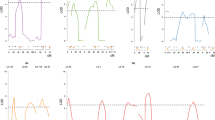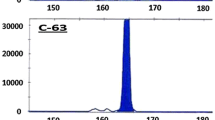Abstract
Sugarcane (Saccharum spp.) is a clonally propagated outcrossing polyploid crop of great importance in tropical agriculture. Up to now, all sugarcane genetic maps had been developed using either full-sib progenies derived from interspecific crosses or from selfing, both approaches not directly adopted in conventional breeding. We have developed a single integrated genetic map using a population derived from a cross between two pre-commercial cultivars (‘SP80-180’ × ‘SP80-4966’) using a novel approach based on the simultaneous maximum-likelihood estimation of linkage and linkage phases method specially designed for outcrossing species. From a total of 1,118 single-dose markers (RFLP, SSR and AFLP) identified, 39% derived from a testcross configuration between the parents segregating in a 1:1 fashion, while 61% segregated 3:1, representing heterozygous markers in both parents with the same genotypes. The markers segregating 3:1 were used to establish linkage between the testcross markers. The final map comprised of 357 linked markers, including 57 RFLPs, 64 SSRs and 236 AFLPs that were assigned to 131 co-segregation groups, considering a LOD score of 5, and a recombination fraction of 37.5 cM with map distances estimated by Kosambi function. The co-segregation groups represented a total map length of 2,602.4 cM, with a marker density of 7.3 cM. When the same data were analyzed using JoinMap software, only 217 linked markers were assigned to 98 co-segregation groups, spanning 1,340 cM, with a marker density of 6.2 cM. The maximum-likelihood approach reduced the number of unlinked markers to 761 (68.0%), compared to 901 (80.5%) using JoinMap. All the co-segregation groups obtained using JoinMap were present in the map constructed based on the maximum-likelihood method. Differences on the marker order within the co-segregation groups were observed between the two maps. Based on RFLP and SSR markers, 42 of the 131 co-segregation groups were assembled into 12 putative homology groups. Overall, the simultaneous maximum-likelihood estimation of linkage and linkage phases was more efficient than the method used by JoinMap to generate an integrated genetic map of sugarcane.









Similar content being viewed by others
References
Al-Janabi SM, Honeycutt RJ, McClelland M, Sobral BWS (1993) A genetic linkage map of Saccharum spontaneum L, ‘SES 208’. Genetics 134:1249–1260
Barreneche T, Bodenes C, Lexer C, Trotin JF, Fluch S, Streiff R, Plomion C, Roussel G, Steinkellner H, Burg K, Favre JM, Glössl J, Kremer A (1998) A genetic linkage map of Quercus robur L. (pendunculate oak) based on RAPD, SCAR, microsatellite, minisatellite, isozyme and 5S rDNA markers. Theor Appl Genet 97:1090–1103
Buetow KH, Chakravarti A (1987) Multipoint gene mapping using seriation. I. General Methods. Am J Hum Genet 41:180–188
Burnquist WL (1991) Development and application of FRLP technology in sugarcane (Saccharum sp) breeding. PhD Dissertation, Cornell University, Ithaca NY, 154 p
Calija V, Higgins AJ, Jackson PA, Bielig LM, Coomans D (2001) An operations research approach to the problem of the sugarcane selection. Ann Oper Res 108:123–142
Carlier JD, Reis A, Duval MF, Coppens D’Eeckenbrugge G, Leitão M (2004) Genetic maps of RAPD, AFLP and ISSR markers in Ananas bracteatus and A. comosus using the pseudo-testcross strategy. Plant Breed 123:186–192
Cordeiro GM, Taylor GO, Henry RJ (2000) Characterization of microsatellite markers from sugarcane (Saccharum sp.) a highly polyploid species. Plant Sci 155:161–168
Creste S, Tulmann Neto A, Figueira A (2001) Detection of single sequence repeat polymorphisms in denaturing polyacrylamide sequencing gel by silver staining. Plant Mol Biol Rep 19:299–306
Da Silva JAG, Sorrells ME, Burnquist WL, Tanksley SD (1993) RFLP linkage map and genome analysis of Saccharum spontaneum. Genome 36:782–791
Da Silva JAG, Honeycutt RJ, Burnquist WL, Al-Janabi SM, Sorrels ME, Tanksley SD, Sobral BWS (1995) Saccharum spontaneum L. ‘SES208’ genetic linkage map containing RFLP and PCR-based markers. Mol Breed 1:165–169
Daugrois JH, Grivet L, Roques D, Hoarau JY, Lombard H, Glaszmann JC, D’Hont A (1996) A putative major gene for rust resistance linked with RFLP marker in sugarcane cultivar R570. Theor Appl Gen 92:1059–1064
Dempster AP, Laird NM, Rubin DB (1977) Maximum likelihood from incomplete data via KM algorithm. J R Stat Soc Ser B 39:1–38
D’Hont A, Ison D, Alix K, Roux C, Glaszmann JC (1998) Determination of the basic chromosome numbers in the genus Saccharum by physical mapping of RNA genes. Genome 4:221–225
D’Hont A, Lu YH, De Léon DG, Grivet L, Feldmann P, Lanaud C, Glaszmann JC (1994) A molecular approach to unravelling the genetics of sugarcane, a complex polyploid of the Andropogoneae tribe. Genome 37:222–230
Doerge RW (1996) Constructing genetic maps by rapid chain delineation. J Agric Genomics 2:6
Dufour P, Deu M, Grivet L, D’Hont A, Paulet F, Bouet A, Anaud C, Glaszmann JC, Hamon P (1997) Construction of a composite sorghum genome map and comparison with sugarcane, a related complex polyploidy. Theor Appl Genet 94:409–418
Grattapaglia D, Sederoff R (1994) Genetic linkage maps of Eucalyptus grandis and Eucalyptus urophylla using a pseudo-testcross: mapping strategy and RAPD markers. Genetics 127:1121–1137
Grivet L, D’Hont A, Roques D, Feldmann P, Lanaud C, Glaszmann C (1996) RFLP Mapping in cultivated sugarcane (Saccharum spp.): Genome organization in a highly polyploid and aneuploid interspecific hybrid. Genetics 142:987–1000
Grivet L, Arruda P (2001) Sugarcane genomics: depicting the complex genome of an important tropical crop. Curr Opin Plant Biol 5:122–127
Guimarães CT, Honeycutt RJ, Sills GR, Sobral BWS (1999) Genetic maps of Saccharum officinarum L. and Saccharum robustum Brandes and Jew. Ex. Grassl. Genet Mol Biol 22:125–132
Hoarau JY, Grivet L, Offmann B, D’Hont A, Risterucci AM, Roques D, Glaszmann JC, Grivet L (2001) Genetic dissection of a modern sugarcane cultivar (Saccharum spp.) I. Genome mapping with AFLP markers. Theor Appl Genet 103:84–97
Hoarau JY, Grivet L, Offmann B, Raboin LM, Diorflar JP, Payet J, Hellmann M, D’Hont A, Glaszmann JC (2002) Genetic dissection of a modern sugarcane cultivar (Saccharum spp) II Detection of QTLs for yield components. Theor Appl Genet 105:1027–1037
Hoisington D, Khairallah M, González-De-León D (1994) Laboratory Protocols: CIMMYT Applied Molecular Genetics Laboratory. CIMMYT, Mexico, DF
Irvine JE (1999) Saccharum species as horticultural classes. Theor Appl Genet 98:186–194
Jannoo N, Grivet L, D’Hont A, Glaszmann JC (2004) Differential chromosome pairing affinities at meiosis in polyploid sugarcane revealed by molecular markers. Heredity 93:460–467
Jannoo N, Grivet L, Seguin M, Paulet F, Domaingue R, Rao PS, Dookun A, D’Hont A, Glazmann JC (1999) Molecular investigation of the genetic base of sugarcane cultivars. Theor Appl Genet 99:171–184
Lander ES, Green P (1987) Construction of multilocus genetic linkage maps in humans. Proc Natl Acad Sci 84:2363–2367
Lander ES, Green P, Abrahamson J, Barlow A, Daly MJ, Lincoln SE, Newberg L (1987) MAPMAKER: an interactive computer package for constructing primary genetic linkage maps of experimental and natural populations. Genomics 1:174–181
Lima MLA, Garcia AAF, Oliveira KM, Matsuoka S, Arizono H, Souza CL Jr, Souza AP (2002) Analysis of genetic similarity detected by AFLP and coefficient of parentage among genotypes of sugar cane (Saccharum spp.) Theor Appl Genet 104:30–38
Liu BH (1998) Statistical Genomics. CRC Press NY, 611 pp
Maliepaard C, Jansen J, Van Ooijen JW (1997) Linkage analysis in a full-sib family of an outbreeding plant species: overview and consequences for applications. Genet Res 70:237–250
Maliepaard C, Alston FH, Van Arkel G, Brown LM, Chevreau E, Dunemann F, Evans KM, Gardiner S, Guilford P, Van Heusden AW, Janse J, Laurens F, Lynn JR, Manganaris AG, Den Nijs APM, Periam N, Rikkerink E, Roche P, Ryder C, Sansavini S, Schnidt H, Tartarini S, Verhaegh JJ, Vrielink Van Ginkel M, King GJ (1998) Aligning male and female linkage maps of apple (Malus pumila Mill.) using multi-allelic markers. Theor Appl Genet 97:60–73
Ming R, Liu SC, Lin YR, Da Silva J, Wilson W, Braga D, Van Deynze A, Wenslaff TF, Wu KK, Moore PH, Burnquist W, Sorrells ME, Irvine JE, Paterson AH (1998) Detailed alignment of Saccharum and Sorghum chromosomes: Comparative organization of closely related diploid and polyploid genomes. Genetics 150:1663–1682
Mudge J, Andersen WR, Kehrer R, Fairbanks DJ (1996) A RAPD genetic map of Saccharum officinarum. Crop Sci 36:1362–1366
Pinto LR, Oliveira KM, Ulian EC, Garcia AAF, Souza AP (2004) Survey in the sugarcane expressed sequence tag data base (SUCEST) for simple sequence repeats. Genome 47:795–804
Porceddu A, Albertini E, Barcaccia G, Falistorco E, Falcinelli M (2002) Linkage mapping in apomictic and sexual kentucky blue grass (Poa pratensis L) genotypes using a two way pseudo-testcross strategy based on AFLP and SAMPL markers. Theor Appl Genet 104:273–280
R Development Core Team, R (2004) A language and environment for statistical computing, Foundation for Statistical Computing.Vienna, Austria 3–900051-07-0 (http://www.R-project.org)
Rossi M, Araujo PG, Paulet F, Garsmeur O, Dias VM, Chen H, Van Sluys MA, D’Hont AD (2003) Genomic distribution and characterization of EST-derived resistance gene analogs (RGAs) in sugarcane. Mol Gen Genomics 269:406–419
Shepherd M, Cross M, Dieters MJ, Henry R (2003) Genetic maps for Pinus elliottii var hondurensis using AFLP and microsatellite markers. Theor Appl Genet 106:1409–1419
Stam P (1993) Construction of integrated genetic linkage maps by means of a new computer package: JoinMap. Plant J 3:739–744
Van Ooijen JW, Voorrips RE (2001) JoinMap Version 3.0 Software for the calculation of genetics linkage maps. Plant Research International, Wageningen, The Netherlands
Vettore AL, Da Silva FR, Kemper EL, Arruda P (2001) The libraries that made SUCEST. Genet Mol Biol 24:1–7
Wu KK, Burnquist W, Sorrells ME, Tew TL, Moore PH, Tanksley SD (1992) The detection and estimation of linkage in polyploids using single-dose restriction fragments. Theor Appl Genet 83:294–300
Wu RL, Han YF, Hu JJ, Fang JJ, Li L, Li ML, Zeng ZB (2000) An integrated genetic map of Populus deltoides based on amplified fragment length polymorphisms. Theor Appl Genet 100:1249–1256
Wu R, Ma CX, Painter I, Zeng ZB (2002) Simultaneous maximum likelihood estimation of linkage and linkage phases in outcrossing species. Theor Popul Biol 61:349–363
Acknowledgments
This work was supported by a grant from “Conselho Nacional de Desenvolvimento Científico e Tecnológico” (CNPq)-PADCT (SBIO 62.0020/99-7) and “Fundação de Amparo à Pesquisa do Estado de São Paulo” (FAPESP 00/05718-7 and 02/01167-1). A.P.S., A.A.F.G. and A.F. receive a research fellowship from “Conselho Nacional de Desenvolvimento Científico e Tecnológico” (CNPq); E.A.K. and H.M.B.S. were recipient of fellowships from “Coordenação de Aperfeiçoamento de Pessoal de Nível Superior (CAPES); A.N.M and L.R.P. were recipients of graduate and post-doctoral fellowships, respectively from FAPESP (00/05718-7; 01/14656-8) and C.S.L. and M.M.P were recipients of undergraduate fellowships from CNPq and FAPESP, respectively. The authors thank G.R.A. Margarido and M. Mollinari for help with the OneMap software development.
Author information
Authors and Affiliations
Corresponding author
Additional information
Communicated by A. Charcosset
E.A. Kido, A.N. Meza and H.M.B. Souza contributed equally to this work.
Rights and permissions
About this article
Cite this article
Garcia, A., Kido, E., Meza, A. et al. Development of an integrated genetic map of a sugarcane (Saccharum spp.) commercial cross, based on a maximum-likelihood approach for estimation of linkage and linkage phases. Theor Appl Genet 112, 298–314 (2006). https://doi.org/10.1007/s00122-005-0129-6
Received:
Accepted:
Published:
Issue Date:
DOI: https://doi.org/10.1007/s00122-005-0129-6




